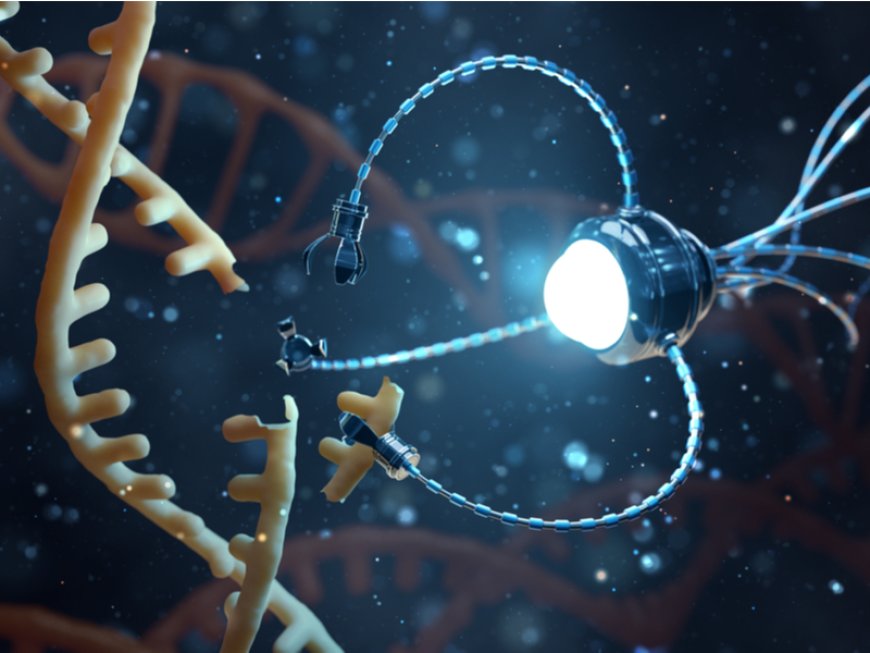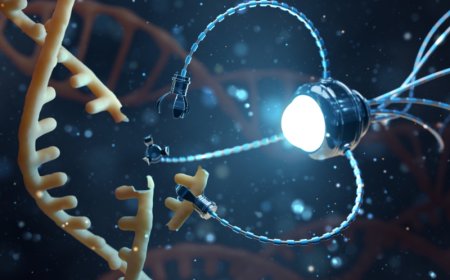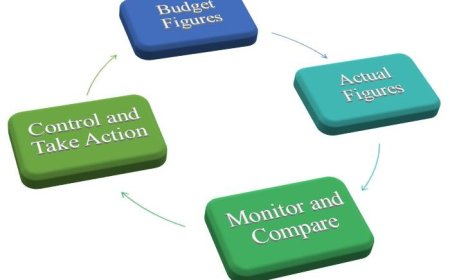Nanotechnology: The Science of the Small and Its Vast Potential
Explore the revolutionary field of nanotechnology, its principles, applications across various industries, and the potential impacts on society, health, and the environment.

Introduction
Nanotechnology, the manipulation and engineering of matter at the nanoscale—typically between 1 to 100 nanometers—has emerged as one of the foremost areas of research and innovation in the 21st century. At this scale, materials exhibit unique physical, chemical, and biological properties that differ significantly from their larger-scale counterparts. This essay explores the principles of nanotechnology, its applications across various fields, the potential benefits and risks associated with its use, and the future prospects of this transformative technology.
The foundational principles of nanotechnology are rooted in the understanding of quantum mechanics and molecular interactions. At the nanoscale, the surface area-to-volume ratio increases dramatically, leading to enhanced reactivity and strength. These characteristics enable the development of materials that are lighter, stronger, and more efficient than traditional materials. For instance, nanomaterials such as carbon nanotubes and nanoparticles have revolutionized fields such as materials science, electronics, and medicine.
In medicine, nanotechnology is paving the way for targeted drug delivery systems that can significantly improve the efficacy of treatments while minimizing side effects. Nanoparticles can be engineered to deliver drugs directly to diseased cells, offering a precision that traditional methods lack. Furthermore, the use of nanosensors in diagnostics allows for earlier detection of diseases, thus enhancing patient outcomes.
In the realm of energy, nanotechnology contributes to the development of more efficient solar cells and batteries, facilitating a transition towards sustainable energy solutions. Nanostructured materials improve the performance of photovoltaic devices, leading to increased energy conversion efficiency. Additionally, the integration of nanotechnology in environmental remediation processes offers innovative solutions for pollution control and resource management.
However, the rapid advancement of nanotechnology also raises important ethical and safety considerations. The potential risks associated with the production and use of nanomaterials must be thoroughly assessed to ensure that they do not pose harm to human health or the environment. Regulatory frameworks are essential to guide the responsible development of nanotechnology, balancing innovation with safety.
Looking to the future, the prospects of nanotechnology are vast and varied. As research continues to unveil new applications, the integration of nanotechnology into everyday life is likely to expand, affecting industries ranging from consumer goods to aerospace. The potential for breakthroughs in fields such as biotechnology, information technology, and environmental science underscores the transformative power of this technology. As we stand on the brink of a nanotechnology revolution, it is imperative to navigate its challenges responsibly while harnessing its potential for the benefit of society.
Understanding Nanotechnology: Definition and Principles
Nanotechnology encompasses the design, characterization, production, and application of structures, devices, and systems through direct control of matter at the nanoscale. A nanometer is one-billionth of a meter, which is about 100,000 times smaller than the diameter of a human hair. At this scale, materials often exhibit quantum mechanical behaviors, which can lead to enhanced optical, electrical, and mechanical properties.
Key Principles of Nanotechnology:
-
Quantum Effects: At the nanoscale, particles showcase distinct quantum phenomena, affecting how they absorb light and conduct electricity. This results in unique attributes such as increased photoluminescence in quantum dots and altered electrical conductivity in nanostructured materials.
-
Increased Surface Area: Nanoparticles possess a high surface area-to-volume ratio, leading to enhanced reactivity and efficiency in catalysis. This characteristic is particularly advantageous in chemical reactions, where the greater surface area allows for more active sites, thereby accelerating reaction rates and improving yield.
-
Self-Assembly: Molecules can be designed to self-organize into useful structures, paving the way for the creation of complex nanostructures through natural processes. This principle mimics biological systems and offers a sustainable approach to manufacturing, minimizing waste and energy consumption.
Types of Nanomaterials:
Nanomaterials can be categorized into different classes based on their structure and properties:
-
Nanoparticles: Solid particles ranging from 1 to 100 nanometers in size, including metals, oxides, and polymers. Their unique properties make them invaluable in applications such as drug delivery, where they can be engineered to target specific cells.
-
Nanotubes: Cylindrical structures with extraordinary strength and electrical conductivity, such as carbon nanotubes. These materials are poised to revolutionize fields like electronics and materials science due to their potential for lightweight and high-strength applications.
-
Nanoplates and Nanowires: Two-dimensional (2D) and one-dimensional (1D) materials with unique physical properties, used in electronic and photonic applications. Their ability to conduct electricity and manipulate light makes them essential in the development of next-generation devices.
-
Quantum Dots: Nanoscale semiconductor particles that produce specific colors when exposed to light, used in displays and biological imaging. Their tunable optical properties enable advancements in imaging techniques and the development of vibrant, energy-efficient displays.
Nanotechnology represents a frontier of innovation, where the manipulation of matter at the nanoscale opens up new possibilities across various fields, including medicine, electronics, and materials science. As research continues to evolve, the potential applications of nanomaterials will undoubtedly expand, promising to reshape our world in profound ways.
Applications of Nanotechnology
Nanotechnology has found utilization in diverse fields, revolutionizing industries ranging from medicine to electronics. Below are some key applications:
- Medicine Nanotechnology has the potential to transform healthcare through targeted drug delivery, diagnostics, and treatment:
- Targeted Drug Delivery: Nanoparticles can be engineered to deliver drugs directly to diseased cells, minimizing side effects and enhancing therapeutic efficacy. For instance, liposomes and polymer-based nanoparticles are used to carry chemotherapeutic agents to tumor cells, ensuring that healthy tissues remain unaffected during treatment.
- Diagnostic Imaging: Quantum dots and nanoprobes enhance imaging techniques for early disease detection by improving the sensitivity and accuracy of diagnostic tests. These advancements facilitate earlier interventions, significantly improving patient outcomes.
- Tissue Engineering: Nanomaterials are used to create scaffolds that support the growth and regeneration of tissues, including bone and cartilage. By mimicking the natural extracellular matrix, these scaffolds promote cellular adhesion and proliferation, paving the way for innovative regenerative therapies.
- Electronics Nanotechnology is integral to the development of smaller, faster, and more powerful electronic devices:
- Transistors and Chips: The miniaturization of transistors using nanoscale materials enhances the performance and efficiency of microprocessors in computers, smartphones, and other devices. This leads to the production of high-performance computing systems that consume less energy.
- Flexible Electronics: Nanomaterials enable the production of lightweight, flexible circuits, paving the way for advancements in wearable technology. These innovations allow for the integration of electronics into clothing, health monitoring devices, and other everyday items.
- Energy Storage: Nanotechnology enhances battery performance, with nanostructured materials improving capacity and charging rates, thereby facilitating the development of more efficient energy storage systems essential for electric vehicles and renewable energy applications.
- Environmental Protection Nanotechnology offers innovative solutions to environmental challenges:
- Pollution Cleanup: Nanomaterials such as titanium dioxide and nanoclays can be employed in water purification and resource recovery, effectively breaking down pollutants and contaminants. These materials possess unique properties that enhance their reactivity and absorption capabilities, making them ideal for environmental remediation.
- Sustainable Energy: Nanotechnology plays a critical role in the development of more efficient solar cells and energy storage systems, contributing to the transition toward renewable energy sources. By improving the efficiency of photovoltaic materials, nanotechnology helps to lower the cost of solar energy, making it more accessible.
- Food and Agriculture Nanotechnology is poised to revolutionize food safety and agricultural practices:
- Food Packaging: Nanomaterials can be incorporated into packaging to enhance barrier properties, extending shelf life and reducing spoilage. These advanced materials can also include antimicrobial properties, ensuring food safety.
- Precision Agriculture: Nanosensors can monitor soil conditions and crop health in real-time, enabling farmers to make informed decisions that optimize resource use and increase yields. This precision approach minimizes waste and promotes sustainable farming practices.
The applications of nanotechnology across various sectors underscore its transformative potential, fostering advancements that can lead to improved quality of life and environmental sustainability.
Benefits of Nanotechnology
The benefits of nanotechnology are vast and far-reaching, influencing numerous sectors and enhancing everyday life.
Enhanced Performance: One of the most significant advantages of nanotechnology is the enhancement of performance in various applications. Nanomaterials often exhibit superior properties, such as increased strength, lighter weight, and improved electrical conductivity. For instance, in the field of electronics, nanoscale components allow for faster processing speeds and reduced energy consumption, which is pivotal for the development of next-generation devices. In the realm of medicine, nanoparticles can be engineered for targeted drug delivery, ensuring that therapeutic agents are released precisely where needed, thereby maximizing efficacy and minimizing side effects.
Cost-Effectiveness: The integration of nanotechnology can lead to substantial cost-effectiveness in production processes. By reducing material requirements through the use of nanoscale materials, manufacturers can minimize waste and optimize resource utilization. This not only lowers production costs but also enhances the overall efficiency of manufacturing processes. Industries such as construction and textiles are already witnessing significant savings and improved product longevity due to the incorporation of nanotechnology.
Innovation: Nanotechnology serves as a catalyst for innovation across multiple sectors, driving the creation of new products and solutions that were previously unimaginable. From advanced coatings that repel dirt and water to revolutionary energy storage systems that improve battery life, the potential for innovation is limitless. The ability to manipulate materials at the atomic and molecular levels opens new avenues for research and development, fostering a culture of creativity and exploration in science and engineering.
Sustainability: In an era where environmental concerns are paramount, nanotechnology plays a crucial role in promoting sustainability. By enhancing energy efficiency and facilitating resource conservation, nanotechnology contributes significantly to environmental stewardship. For example, nanomaterials can improve the efficiency of solar cells, thereby increasing the viability of renewable energy sources. Additionally, nanotechnology can aid in water purification processes, ensuring access to clean water while minimizing the ecological footprint of traditional purification methods.
The multifaceted benefits of nanotechnology—from enhanced performance and cost-effectiveness to innovation and sustainability—underscore its transformative potential. As research and development continue to advance in this field, the implications for industries and society at large are profound, paving the way for a more efficient, innovative, and sustainable future.
Risks and Ethical Considerations in Nanotechnology
Despite its many advantages, nanotechnology also presents potential risks and ethical challenges that must be navigated with caution.
Health Risks: The long-term health effects of exposure to nanoparticles are not yet fully understood. Concerns exist regarding inhalation, skin contact, and ingestion of nanomaterials. Preliminary studies suggest that certain nanoparticles may elicit toxic responses in biological systems, leading to inflammation or cellular damage. The potential for accumulation in human tissues raises alarms about chronic exposure, necessitating rigorous research to establish safe exposure thresholds and identify vulnerable populations.
Environmental Impact: The introduction of nanomaterials into ecosystems may have unforeseen consequences on biodiversity and natural processes. For instance, nanoparticles can alter soil chemistry, potentially affecting plant growth and the health of soil microorganisms. Aquatic ecosystems may also be at risk, as nanoparticles can enter waterways through runoff or wastewater, impacting aquatic life and disrupting food chains. Comprehensive environmental assessments are essential to understand the fate and transport of these materials in various ecosystems, ensuring that their benefits do not come at the cost of ecological integrity.
Ethical Issues: The use of nanotechnology raises ethical questions related to privacy, access, and equity in technological benefits. The potential for nanoscale surveillance devices poses significant privacy concerns, as they could enable unprecedented levels of monitoring in both public and private spheres. Moreover, disparities in access to nanotechnology could exacerbate existing inequalities, with wealthier nations or individuals reaping the benefits while marginalized communities remain at a disadvantage. This raises critical questions about the equitable distribution of technological advancements and the responsibility of innovators to ensure that benefits are shared broadly.
Regulatory Framework: To address these risks, regulatory agencies around the world are developing guidelines for the safe use and management of nanotechnology. For instance, the U.S. Environmental Protection Agency (EPA) and the European Chemicals Agency (ECHA) provide frameworks for assessing the safety of nanomaterials, emphasizing a precautionary approach. These frameworks encourage ongoing dialogue among scientists, policymakers, and the public to establish clear regulations that prioritize human health and environmental sustainability.
While nanotechnology holds immense promise for various fields, a balanced approach that considers health risks, environmental impacts, and ethical implications is paramount. By fostering collaboration among stakeholders, we can harness the potential of nanotechnology responsibly and equitably, paving the way for innovations that benefit society as a whole.
Future Prospects of Nanotechnology
The future of nanotechnology is promising, with ongoing research and development expanding its applications and potential. Key areas of growth include:
Healthcare Advances: Continued exploration of nanomedicine may lead to breakthroughs in gene therapy, personalized medicine, and regenerative medicine. The ability to manipulate materials at the nanoscale opens avenues for targeted drug delivery systems that can significantly enhance the efficacy of treatments while minimizing side effects. For instance, nanoparticles can be engineered to deliver chemotherapeutic agents directly to cancer cells, sparing healthy tissues and improving patient outcomes. Furthermore, advances in nanosensors could enable real-time monitoring of biological markers, facilitating early disease detection and more precise treatment protocols tailored to individual patient profiles.
Sustainable Development: Nanotechnology can play a pivotal role in addressing global challenges, such as climate change, food security, and clean energy. Nanomaterials are being developed for use in energy storage and conversion systems, such as batteries and solar cells, which can lead to more efficient and sustainable energy solutions. Additionally, nanotechnology can enhance agricultural practices through the development of nanoscale fertilizers and pesticides that improve crop yield while reducing environmental impact. By optimizing resource use and minimizing waste, nanotechnology can contribute significantly to sustainable practices that ensure food security for a growing global population.
Interdisciplinary Collaborations: As nanotechnology intersects with fields such as robotics, artificial intelligence, and biotechnology, the potential for innovative solutions increases significantly. The convergence of these disciplines can lead to the development of smart materials that adapt to their environment, enhancing the functionality of devices ranging from wearable health monitors to advanced robotics. For example, integrating AI with nanotechnology can facilitate the design of self-healing materials that respond to damage autonomously, revolutionizing industries from construction to electronics.
Moreover, the integration of nanotechnology in environmental remediation efforts holds promise for cleaning up pollutants at unprecedented efficiency, utilizing nanoscale materials to break down contaminants or absorb toxins. The collaborative efforts across various scientific domains will not only accelerate the pace of innovation but also ensure that nanotechnology addresses some of the most pressing challenges faced by society today.
The future of nanotechnology is not just about technological advancement but also about fostering a sustainable and healthier world. As research continues to evolve, the interdisciplinary nature of nanotechnology will undoubtedly unlock new possibilities, paving the way for transformative solutions that enhance quality of life while safeguarding our planet.
Conclusion
Nanotechnology represents a frontier of cutting-edge science with transformative potential across numerous industries. From healthcare advancements to environmental remediation and enhanced electronics, the applications of nanotechnology are vast and may address some of humanity's most pressing challenges. In healthcare, for instance, nanoscale materials are revolutionizing drug delivery systems, enabling targeted therapies that minimize side effects and maximize efficacy. Similarly, in the realm of environmental remediation, nanomaterials are being employed to detoxify pollutants, offering innovative solutions to restore ecosystems and improve water quality.
Moreover, the integration of nanotechnology into electronics has led to the development of smaller, faster, and more efficient devices. By leveraging the unique properties of nanomaterials, manufacturers can create components that not only enhance performance but also reduce energy consumption, contributing to a more sustainable technological landscape. As these advancements unfold, the potential for nanotechnology to drive economic growth and create new markets becomes increasingly evident.
However, the responsible development and deployment of nanotechnology are crucial to mitigating risks and ensuring ethical considerations are taken into account. As we navigate this uncharted territory, it is imperative that scientists, policymakers, and industry leaders collaborate to establish regulatory frameworks that prioritize safety, transparency, and public engagement. This collaborative approach will help to address concerns related to environmental impact, human health, and social equity, fostering a culture of responsibility within the nanotechnology sector.
As research continues and the field evolves, embracing the possibilities of nanotechnology while remaining vigilant about its implications will pave the way for a future enriched by innovation and sustainable practices. Educational initiatives aimed at increasing public awareness and understanding of nanotechnology will also play a vital role in shaping perceptions and fostering informed discussions about its benefits and risks.
The journey of nanotechnology is just beginning, and its potential to reshape industries and improve lives is immense. By prioritizing ethical considerations and responsible innovation, we can harness the power of nanotechnology to create a brighter, more sustainable future for generations to come. The challenge lies not only in the scientific advancements but also in our ability to navigate the complexities that accompany such profound change.
What's Your Reaction?
 Like
0
Like
0
 Dislike
0
Dislike
0
 Love
0
Love
0
 Funny
0
Funny
0
 Angry
0
Angry
0
 Sad
0
Sad
0
 Wow
0
Wow
0










































